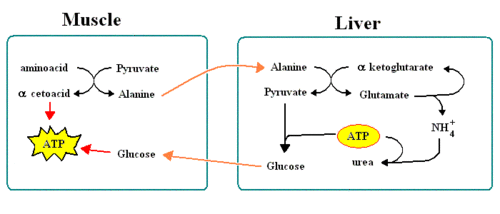Alanine cycle: Difference between revisions
imported>Pedro Silva No edit summary |
mNo edit summary |
||
| (4 intermediate revisions by 4 users not shown) | |||
| Line 1: | Line 1: | ||
{{subpages}} | |||
[[Image:Alanine_cycle.GIF|thumb|500px]] | [[Image:Alanine_cycle.GIF|thumb|500px]] | ||
The '''alanine cycle''' is a way for muscle cells to use [[amino acid]]s as energy sources, while transferring to the liver the expensive task of dealing with the [[ammonium]] released from those aminoacids. | The '''alanine cycle''' is a way for muscle cells to use [[amino acid]]s as energy sources, while transferring to the liver the expensive task of dealing with the [[ammonium]] released from those aminoacids. | ||
Muscles contain [[transaminases]] which transfer the [[amino]] group from amino acids to [[pyruvate]], yielding [[alanine]] and a α-ketoacid similar to the original amino acid. The α-ketoacid is further metabolized, yielding [[adenosine triphosphate|ATP]]. Alanine is transported though the bloodstream, where it is transaminated to pyruvate, which is converted through [[gluconeogenesis]] into glucose. The amino group released from alanine is taken up by α-ketoglutarate, converting it to glutamate. NH<sub>4</sub><sup>+</sup> is removed from glutamate by [[glutamate dehydrogenase]], and incorporated in [[urea cycle|urea]], which is excreted in urine. | Muscles contain [[transaminases]] which transfer the [[amino]] group from amino acids to [[pyruvate]], yielding [[alanine]] and a α-ketoacid similar to the original amino acid. The α-ketoacid is further metabolized, yielding [[adenosine triphosphate|ATP]]. Alanine is transported though the bloodstream, where it is transaminated to pyruvate, which is converted through [[gluconeogenesis]] into glucose. The amino group released from alanine is taken up by α-ketoglutarate, converting it to glutamate. NH<sub>4</sub><sup>+</sup> is removed from glutamate by [[glutamate dehydrogenase]], and incorporated in [[urea cycle|urea]], which is excreted in urine.[[Category:Suggestion Bot Tag]] | ||
[[Category: | |||
Latest revision as of 17:01, 7 July 2024
The alanine cycle is a way for muscle cells to use amino acids as energy sources, while transferring to the liver the expensive task of dealing with the ammonium released from those aminoacids.
Muscles contain transaminases which transfer the amino group from amino acids to pyruvate, yielding alanine and a α-ketoacid similar to the original amino acid. The α-ketoacid is further metabolized, yielding ATP. Alanine is transported though the bloodstream, where it is transaminated to pyruvate, which is converted through gluconeogenesis into glucose. The amino group released from alanine is taken up by α-ketoglutarate, converting it to glutamate. NH4+ is removed from glutamate by glutamate dehydrogenase, and incorporated in urea, which is excreted in urine.
